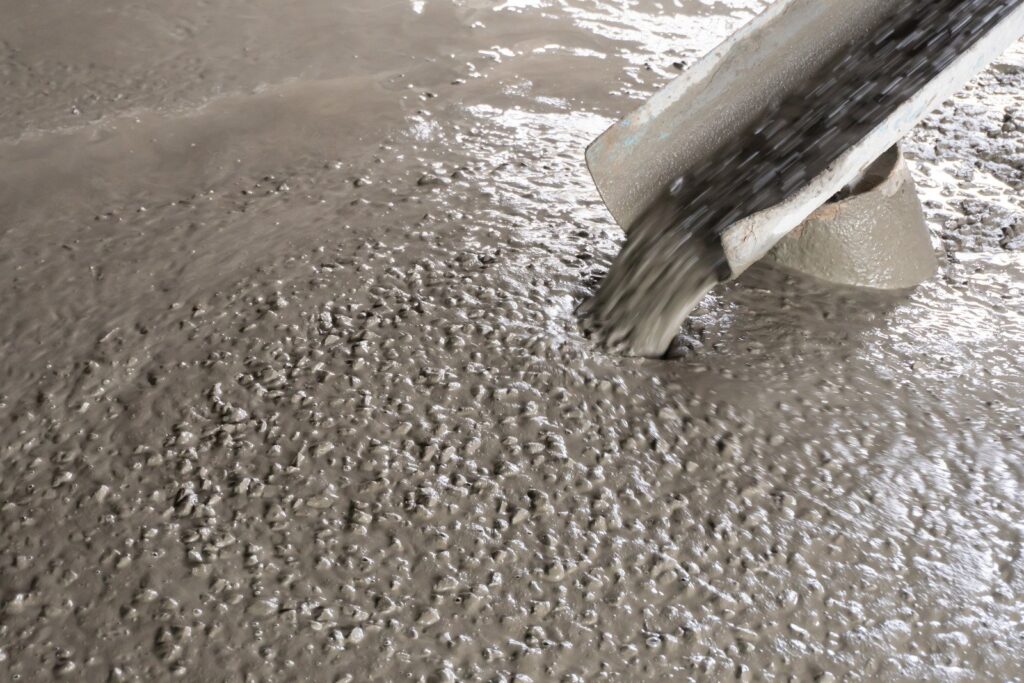When pouring concrete in Marietta, GA, you need to be mindful of the area’s high humidity. Humidity can greatly affect the curing process, leading to potential issues if not managed properly. It’s essential to understand how to prepare your site, choose the right mix, and implement effective curing techniques. Ignoring these factors can compromise the integrity of your installation, posing long-term risks. Let’s explore the best practices to guarantee ideal results for your concrete projects.

Key Takeaways
- Choose a concrete mix with water-reducing admixtures to maintain workability and enhance durability in humid conditions.
- Ensure site drainage is adequate to prevent water pooling, which can compromise concrete integrity.
- Use wet burlap or plastic sheeting to cover the surface and retain moisture during curing.
- Regularly monitor environmental conditions and mist the surface to prevent excessive evaporation.
- Avoid pouring concrete during peak heat hours to minimize temperature fluctuations and evaporation risks.
Understanding Humidity and Its Impact on Concrete Curing
When humidity levels rise, you mightn’t realize how greatly it affects the curing process of concrete. High humidity can slow down the evaporation of water essential for hydration, leading to extended curing times.
While this sounds beneficial, it can actually cause surface issues like scaling or efflorescence, which compromise the concrete’s integrity. Conversely, low humidity accelerates evaporation, necessitating additional measures to maintain moisture levels.
You’ll need to monitor environmental conditions closely and adjust your curing techniques accordingly. Implementing methods such as using curing compounds or wet coverings can help mitigate humidity effects.
Understanding these dynamics guarantees you achieve peak strength and durability in your concrete, despite the challenges presented by a humid climate.
Preparing the Site for Successful Concrete Pouring
Successful concrete pouring hinges on thorough site preparation, which lays the foundation for a durable and resilient structure.
Begin by evaluating site drainage to guarantee water won’t pool around your pour area. Proper drainage prevents moisture from compromising the concrete’s integrity.
Next, focus on surface preparation; clear debris, vegetation, and loose soil to achieve a stable base. Compact the soil to minimize settling, which can lead to cracks. If necessary, use gravel or crushed stone to improve drainage and stability.
Finally, check the weather conditions before pouring, as humidity can affect curing times.
Choosing the Right Concrete Mix for Humid Conditions
Choosing the right concrete mix is crucial, especially because humid conditions can significantly impact the curing process.
To guarantee peak performance, you’ll need to concentrate on moisture control. A mix designed for high humidity should include water-reducing admixtures, which maintain workability while minimizing excess moisture.
Additionally, consider using specific mix additives that improve durability and strength, such as pozzolanic materials or fibers. These additives can boost resistance to cracking and shrinkage, which is critical in humid climates.
It’s also wise to select a mix with a lower water-to-cement ratio to prevent issues related to excessive moisture.
Techniques for Proper Curing in High Humidity
Although high humidity can complicate the curing process, employing the right techniques guarantees that your concrete achieves ideal strength and durability.
First, ascertain effective moisture retention by covering the surface with wet burlap or plastic sheeting; this prevents rapid evaporation. Additionally, consider using curing compounds that form a film over the concrete, sealing in moisture. Apply these compounds as soon as finishing operations are complete to maximize effectiveness.
Monitor the curing environment closely; even in humid conditions, wind or sun can increase evaporation rates. Regularly check moisture levels and, if necessary, mist the surface to maintain adequate hydration.
Common Mistakes to Avoid When Pouring Concrete in Humid Weather
When pouring concrete in humid weather, it’s crucial to avoid common pitfalls that can compromise the integrity of your project. One major mistake is failing to manage temperature fluctuations; high humidity can cause rapid cooling, leading to cracking. Make certain you monitor the temperature closely and adjust your mix accordingly.
Another critical error is neglecting water retention. Excess moisture can weaken your concrete, so consider using additives that help reduce water-cement ratios while maintaining workability.
Additionally, avoid pouring during the hottest part of the day, as this can exacerbate evaporation rates. By addressing these issues, you can greatly improve the durability and longevity of your concrete installation in Marietta’s challenging climate.
Frequently Asked Questions
What Is the Best Time of Day to Pour Concrete in Humid Weather?
You should consider morning pours when temperatures are cooler, minimizing evaporation. Evening pours can also be effective, but humidity may increase. Analyze weather conditions and choose the time that best guarantees ideal curing and strength.
How Does Humidity Affect the Strength of Concrete Over Time?
Humidity affects concrete curing by slowing moisture evaporation, which can improve hydration but may lead to uneven strength if not managed. You’ll need to monitor conditions carefully to guarantee ideal strength development over time.
Can I Pour Concrete During a Rainstorm in Humid Conditions?
Pouring concrete during a rainstorm can negatively affect your project. Rain impacts moisture control, leading to improper curing and potential strength issues. It’s best to wait for drier conditions to guarantee ideal results.
What Precautions Should I Take for Concrete Delivery in High Humidity?
When planning concrete delivery in high humidity, guarantee moisture control by scheduling delivery during cooler periods. Monitor weather conditions closely and adjust your timing to prevent excessive moisture from affecting the mix’s performance and curing process.
How Long Should I Wait Before Sealing Concrete in Humid Conditions?
You should wait at least 28 days for adequate drying time before sealing concrete in humid conditions. Employ effective sealing techniques to guarantee proper adhesion and avoid trapping moisture, which could compromise the surface integrity.
Conclusion
In Marietta’s humid climate, adhering to best practices for pouring concrete is essential for achieving durable results. By understanding humidity’s effects, preparing your site effectively, and selecting the right mix, you set the foundation for success. Implementing proper curing techniques and avoiding common mistakes will further improve the longevity of your installation. By following these guidelines, you guarantee your concrete withstands the challenges posed by humidity, ultimately leading to a resilient and long-lasting surface.
